The more loads you heat treat, the lower the cost per pallet. Operating the kiln with two truck loads per day will probably bring cost down 20-30 cents per pallet or if you are only heat treating a few truck loads per week the cost will likely jump to 40-50 cents per pallet. The general break-even point is one truck load (560-600 pallets) per day for a end-loaded pallet kiln (half a truck load is break even for a Piggy-back installation). We have seen where as few as 300 pallets per week has been profitable for our customers. Net profit could range from US$ 1000 to more than US$: 20000 per month.
For a detailed profit potential analysis please visit economics section for pallet kilns.
We have seen very little and often no drying defects on standards pallets. We are not trying to dry the pallets during the heat treatment process. During a few studies we have seen about a 3-7% moisture loss per HT cycle, which is insignificant on green pallets. On drier recycled pallets we see a little more degrade and a water mist system might help prevent some of these drying defects, although our current customers that heat treat recycled pallets do not have a problem. It is important to understand that one of the greatest threats to pallets that have been heat treated is Mold. So the drying climate of a direct heat source helps reduce this chance, or maybe even drying the pallet make sense for your customer.
Study on the effects of heat treating a load of pallets. Before and after pictures plus weight loss can seen below.
During a heat treatment process we are not trying to dry the pallet and the vents stay closed throughout the heat treatment period. During the heat treatment cycle a little drying will occur, normally about 3-7%. You will probably find that a pallet will dry more on a flat bed truck during transport than during the heat treatment process.
On recycled pallets, which are generally much drier, do not have the same moisture available in the pallet and a few more defects are likely. Since customers of recycled pallets are not looking for the same visible quality as customers of new pallets, this does not seem to be a problem. If you or your customer find that you would like to reduce the drying defects a high pressure spray system can be installed to help bring up the relative humidity faster.
A direct gas heating system will create a little drier climate than an indirect heat systems, such as hot water coils, steam coils, or tube based indirect gas heating. Indirect heating systems tend to use 15-25% more energy than direct gas heating systems.
This test was performed at Granville Pallet Company in North Carolina during the certification run. Timber Products Inspection has certified the kiln and the facility. They also will be performing the monthly inspections. This test and comparison run was performed in one our our end-loaded High Capacity Standard pallet kilns with a direct gas heating system.
| Background for test run and comparison | |
|---|---|
| Location: | Granville Pallet Company |
| Inspection agent: | Timber Products Inspection |
| Kiln type: | End-loaded High Capacity Standard using a direct gas heating system |
| Controller type: | Kiln-direct heat treatment controller using internal temperature sensor into the pallet stringers |
| Pallet to be heat treated: | Mainly stringer pallets with 1 7/8" stringers that takes about 50% longer than your average 1 1/8" stringer |
Based on this and earlier certifications we have the following comments:
Documentation from this test run: temperature readings by TPI during the certification. (146 KB pdf)
For this certification process we took pictures of and weight of eight pallets before and after the heat treatment process to learn more about the actual effects of using direct gas heating. Please view the collected information and pictures in the table below.
| Before | After |
|---|---|
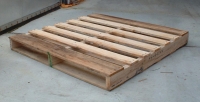 Weight: 66 lbs |
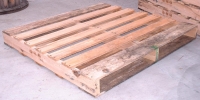 Weight: 59 lbs |
 Weight: 72 lbs |
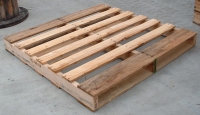 Weight: 68 lbs |
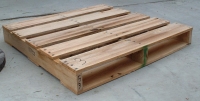 Weight: 53 lbs |
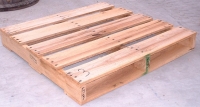 Weight: 50 lbs |
 Weight: 75 lbs |
 Weight: 72 lbs |
 Weight: 74 lbs |
 Weight: 73 lbs |
 Weight: 72 lbs |
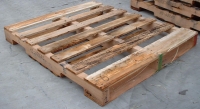 Weight: 71 lbs |
 Weight: 72 lbs |
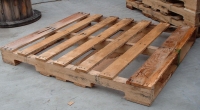 Weight: 72 lbs |
 Weight: 70 lbs |
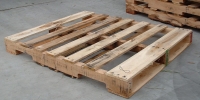 Weight: 68 lbs |
For most situations it takes 10-30 hours to dry a green pallet depending on:
- what final moisture content is your target
- what wood species is the pallet made of
- which kiln model you have
- outside temperature
What does it cost to dry a pallet in energy:
- LPgas: $0.50 to $1.20
- Natural gas: $0.20 to $0.50
Let us ask you this: Why would anyone purchase a pallet kiln without also wanting the ability to dry pallets. Well, not all pallet heat treatment kilns on the market today can be used to both heat treat and dry pallets. Kiln-direct does not design kilns or control systems without this dual purpose accept for the Piggy-back HT system for converting an insulated van or container into a pallet kiln. Our kiln computer software even allows you to develop hundreds of individual heat treatments or drying programs to easily serve your complete customer base.
It is possible to dry pallets in a pallet heat treatment kiln if you have a way to vent the moisture from the pallets to the outside. This can either be a constant venting system that open and closes during the heat treatment cycle based on wet bulb temperature or partial venting based on a certain chamber temperature. The latter method was developed for drying firewood and proved to be the best way for most of our customers that dry pallets.
Yes all Kiln-direct pallet kilns are also designed to dry pallets efficiently but there is more to drying pallets efficiently and economically than meets the eye. In most cases it more about what is "good enough" than perfect drying to a certain moisture content. Below we have compiled an estimated / theoretical energy consumption and cost to dry 1 GMA pallet.
| Energy type cost comparison | |
|---|---|
| Approximate weight of GMA pallet green: | 45 lbs |
| Approximate weight of GMA pallet dried to 19%: | 32 lbs |
| Total weight loss during drying to 19% MC: | 13 lbs |
| Total energy needed dry 1 pallet: | 32500 btu (2500 btu per lbs of water evaporated) |
| LPgas: | 32500 btu = 1/3 gallon of LPgas @ $2.00 / US$: 0.67 per pallet |
| Natural gas: | 32500 btu = 1/3 therm of Natural gas @ $0.70 / US$: 0.23 per pallet |
| Electric heat: | 32500 btu = 9.50 KW electricity @ $0.11 / US$: 1.04 per pallet |
The drying process in the table above is probably a 20-24 hour drying time. But it will depend on wood species, type of pallet, incoming MC%. Light drying often takes around 12 hours and will help reduce the chance of mold and will in many cases be sufficient. Thorough drying will often take 20-24 hours and in some cases longer.
We normally say between 5 to 15 cents per pallet in heating costs. This will depend on many factors:
- Pallet weight.
- Pallet moisture content.
- Energy costs.
- Pallet temperature (at beginning)
- Pallet design (dimension of thickest lumber component)
Of course saying 5 cents per pallet is easy and only a general rule of thumb. Based on our customer experience we have seen costs as low as 2 cents during the summer using natural gas and up to 15 cents in the winter (in Indiana) using LP gas.
| Energy usage and cost when heat treating 1 GMA pallet (green) | |
|---|---|
| Weight of 1 GMA pallet | 45 lbs |
| Incoming temperature | 30-40 F |
| Average temperature when HT complete (140F inside and 200F outside) | 170 F |
| Temperature increase for each pallet | 130 F |
| BTU needed in theory to heat treat 1 pallet (130btu/lbs x 45 lbs) | 5850 btu/pallet |
| REALISTIC BTU consumption after 80% heating efficiency | 7300 btu/pallet |
| LPgas cost: | 7300 btu = 0.08 gallon of LPgas at $2.00 (2 x 0.08) / US$ 0.16 per pallet |
| Natural gas cost: | 7300 btu = 0.07 Therm of Natural gas at $0.80 (0.80 x 0.07) / US$: 0.056 per pallet |
| Electric heat cost: | 7300 btu = 2.1 KW of electric heat at $0.11 (2.1 x 0.11) / US$: 0.23 per pallet |
We have also heard claims that some kilns only use 1 cent per pallet, which is possible on pallets that weigh 20-30 lbs, 1" stringers, and with a starting temperature of 90 F; however, this is not your typical run. Basicly, all systems use about the same amount of energy to heat the pallets plus a waste factor. The energy waste factor will depend on the chamber insulation (more is better and no thermal conductors), heat system efficiency (direct heat is higher/better), adequate and even air flow (too little will extend the process), and length of treatment period (shorter is better). So when comparing the hype from different kiln manufactures look at the building and design facts to make an educated choice. We believe it is important for you to realize that the energy cost is only a small portion of the total cost of heat treating pallets.
Yes, Mold can begin growing on already heat treated pallets. Although heat treating pallets will kill existing mold (it is dead but will not remove it physically), it will not prevent mold from attacking the pallet after heat treating. Actually, based on our current experiences heat treating pallets (without any drying) increases the likeliness of mold. The only way to reduce or nearly eliminate mold is to either dry the pallets or some kind of chemical surface treatment (by dipping or spraying the pallets). Kiln-direct pallet kilns and controls are always designed to both heat treat and dry pallets. A cool down cycle after the heat treatment process can also be very beneficial, some of our customers spend as much time cooling down as heating up to lower the risk.
Let us first warn you that this detailed answer is a little bias to our own system and we will be blowing our own horn a little bit. Since we feel very fortunate that we have designed kilns that help reduce and eliminate this problem from the beginning.
Mold can attack lumber that is above a certain moisture content (most experts believe this critical moisture level to be between 22% to 30%). Although most heat treatment processes (except direct steam heat treating) removes some moisture from the pallets it is not sufficient to get the pallets sufficiently dry to eliminate or minimize the conditions for mold to attack and grow. Actually, based on our current experiences the heat treatment process may push some of the moisture and sugar to the surface. This provides mold with both good conditions to develop and grow and may even make mold a little more likely on heat treated pallets than non-heat treated pallets.
How to solve this problem:
1. Cool down the pallets properly:
This is probably the most common method we see to significantly reduce the potential of mold. Cool down can either happen by leaving the pallets for 4-8 hours in a well ventilated area of fresh air. If you have purchased a Kiln-direct pallet kiln you also have the option of making the cool down part of the heat treatment cycle. All our kilns have high capacity power exhaust that allow for efficient cool down of the pallets and remove surface moisture as part of the HT cycle.
The cooling down has two significant benefits for reducing the potential of mold. First, if a load of hot pallets (not dried) is placed directly into a container or van they will cool down by releasing moisture and creating a water saturated climate, during the warmer weather this makes mold almost certain if the pallets are left in the container/van for several days. Secondly, when you cool down the pallets while still in the kiln for up to 2-3 hours you will be removing a significant amount of surface moisture and latent heat energy. This means they do not "steam" up the container or van in the same way as before. Furthermore, most of Kiln-direct pallet kilns use a direct gas heating system with also creates a drying climate during the whole process = a drier surface = lower chance of mold.
2. Kiln drying pallets
You can kiln dry pallets and crating components in about 15-20 hours in most situations (Some lumber drying experts still claim that it will take 4-7 days, but we have proven otherwise). This drying brings the average moisture content to 15-25%. This should be sufficient to minimize the chance of mold (not eliminate totally, but minimize the chance). Not all kiln systems can accomblish this in the mentioned time frame. But nearly all Kiln-direct pallet kilns have been designed for drying standard stringer (also oak) pallets in the mentioned time frames.
3. Chemical treating
A few of our customers use an anti-fungicide to eliminate or reduce mold on both heat treated and non-heat treated pallets. This can either be done as part of the production line with a spray booth or in a separate dip tank.
Each facility is certified and will require monthly visits by the inspection agency. During the first inspection visit to get your facility setup, you will be required to view the kiln and probably perform a test or test run to be certain that your kiln can actually heat treat pallets.
First and foremost you do not need to purchase a certified kiln, since it is your facility that needs to be certified. You should however be certain that the kiln components/design or the turn-key kiln either has been certified at other facilities or meet the specifications of the inspection agency. You can actually build your own chamber based on your own design as long as it passes the inspection. Kiln-direct kilns have passed certification by several of the inspection companies and this is usually always accomplished in one day.
A direct gas heating system is the most efficient, with nearly 100% efficiency. Which means that all of the combustion energy goes into heating the air in the kiln. Normally the gas flame is located in a separate duct (should be stainless steel) with air circulation from the general chamber, which is heated with the gas flame and returned to the kiln chamber at a higher temperature. A direct heat system uses a heat transfer surface to separate the combustion air from the kiln air. On a indirect heat system the combustion air is vented to the outside normally at a stack temperature or 200-350 degrees F. Since some of the energy from the combustion escapes out the stack these system will often have an efficiency between 70-90%, this will result in 15-40% higher energy consumption.
We are developing detailed answer, please return soon for the detailed answer.
Steam heating was the initial favorite method by the kiln experts and it certainly was the fastest heating method (which does not mean the best) for penetrating a piece of wood. However, the free market and the industry has found dry heat to be both the most economical and technical solution for several reasons. Today we have seen no problem using temperatures as high as 250-300F (120-150C). This seems unbelievable on the surface, but the pallet is only dried by about 3-10%, which is not sufficient to create any damage. The cycle time is very short which also helps reduce any potential damage.
Steam was initially seen as the solution by many kiln experts and it had many characteristic that made it the obvious choice. It was speculated that dry heat would probably damage the pallets, which would not be an issue with direct steam heated.
The key to efficient and fast heat to 56C or 133F is to have a wet bulb temperature significantly higher than this. You can achieve this high wet bulb temperature either by higher humidity or high dry bulb temperature. We found that raising the dry bulb was the most practical. During many actual test runs on pallets we have found that it is no problem using temperatures as high as 250-300F (120-150C) in the kiln without any significant signs of damage to the pallets. This seems unbelieveable on the surface, but the pallet is only dried by about 3-10%, which is not sufficient to create any damage.
Another significant advantage in raising the dry bulb temperature is that a little more drying occurs, this helps reduce the chance of mold after the heat treating process, which is a big problem with steam heating pallets.
First this is often an area that ends up being bragging rights among Pallet kiln manufacturers. The heat treatment time will depend on the following major factors: Initial starting temperature, the thickness of the largest piece of wood in the pallet, the size of the heat source, and adequate air flow. Some of the minor influences are: Species, moisture content, and building insulation. Therefore, the better question to ask is, How does the pallet kiln I am considering compare to another in specifications and design? Lastly, the type of control system that does not use internal sensors will take much longer than control systems that rely on internal temperature probes in the pallets.
Our most popular models of end-loaded pallet kilns will normally take 1.5 - 4 hours depending on the factors above. Our best and most powerful model High Efficiency Side-loaded has completed pallet heat treatment cycles in some very impressive times. On one occasion the pallets started with a temperature of about 10F and completed the actual treatment in right under 2 hours (90 minutes to reach 135F internally and then hold for 30 minutes.)
As mentioned above this is a rather difficult question to answer without specific information about the pallet. Even then we have a hard time estimating the actual heat treatment time. Below we have listed the factors that have an influence on the treatment time and the theory behind this.
Major factors that determine the treatment time:
1. Initial starting temperature
This is obvious, but lets examine it a little. We will take water as a standard for this example. It takes one BTU to heat one pound of water one degree The same is true for pallets as well, not taking the energy waste into account. If it takes 2 million BTU's (586kw) to raise the temperature from 85F to 135F in a load of pallets, it will take 4 million BTU's (1172kw) to raise the temperature from 35F to 135F. Why? The temperature differential from 135 to 85 is 50 degrees and the temperature differential from 135 to 35 is 100 degrees; twice as much difference means twice as much energy is needed.
2. Thickness of the largest piece of wood in the pallet
This is obvious and based on our experience it seems like the length of the heat treatment time will increase propotionately with the thickness of the wood. You can compensate some by increasing the chamber temperature. A pallet with thicker wood (such as a block pallet) will not necessarily need more energy. Therefore, it will allow the heating system to achieve a higher chamber temperature faster, since the pallet consumes less energy per hour.
3. Size of the heat source
The heat source is a little like a bottle neck, either it provides enough heat and the process is not slowed or it is not able to provide sufficient heat. However, in the very beginning of the process the size of the heat source is directly related to the speed with which the pallets are heated. The thinner the largest wood piece is on your pallets the more the latter statement is true.
4. Adequate air flow
The air in the kiln acts as the heat transfer agent between the heating source and the pallets. As the air becomes more humid it is able to carry more energy to the pallets per cubic foot/meter of air. This is one of the reasons it is desireable to have a very well sealed chamber (the other is to achieve a high humidity to avoid drying defects). Adequate air flow means not too little and not too much. Too much air flow may actually dry the pallet during the initial heat up period when the air has not become saturated with moisture. As part of the air flow equation one should also consider the lenght of air travel from entering the pallets to existing. Naturally the pallets on the existing side will recieve less heat and reach the required treatment temperature last. Reversing the fans may help reduce this problem. It is our experience that 40-50 feet is maximum when using reversing fans.
Yes, kiln-direct works and recommends several leasing companies and will work with your prefered leasing company as well. Both the turn-key pallet kiln as well as the kilns you build yourself can be leased.
Leasing a pallet kiln can often be the best economical choice. Advice about this should be left to professionals, such as your CPA, financial consultant, or in house financial officer. We do have a few pointers in choosing a leasing company. First, we have always believe in shopping around for the best rates, but you must be careful. Having many companies run a credit check on the company can reduce its rating and your future ability to obtain good rates. Although limiting the amount on the application with leasing companies will also limit competition but it is wise to do so.
We have both worked with leasing companies on turn-key kilns and on kilns constructed locally. Often it will be easier to obtain better rates and conditions on the turn-key solution, since it can easily be moved to another locations.
There are very few combustable parts on a pallet kiln, however, most problems we have seen have been with the temperature sensors. This is normally not due to wear and tear, but rather mishandling. There are a few burner components we believe is a good idea to keep in stock. Also, remember that we can generally send instock parts by next day air, if so needed.
We will provide you with a short and extended list. The extended list will generally apply to older units located in a remote area without easy access to maintain parts. These lists are based on our standard design with direct gas heat system, such as the turn-key pallet kiln.
| Short list | |
|---|---|
| 2-4 pcs. | Temperature sensor, type WSUS-SENSOR-PT100 |
| 1 pc. | Print circuit for four channel RTD/PT100 to 4-20mA converter type WSUS-SENSOR-4mA/PT100 |
| 1 pc. | Communication board, type F2-UNICON (not needed on wireless setups) |
| 1 set | Various fuses, all have the dimensions 5x20mm and are slow-blow: 2-4 pcs. 500mA, 5-10 pcs. 5A |
| Extended list | |
|---|---|
| 2-4 pcs. | Temperature sensor, type WSUS-SENSOR-PT100 |
| 1 pc. | Print circuit for four channel RTD/PT100 to 4-20mA converter type WSUS-SENSOR-4mA/PT100 |
| 1 pc. | Analog input module (F0-04AD-2) and maybe a input/output module (F004AD2DA-2) |
| 1 pc. | Pilot assembly cartridge for burner |
| 1 pc. | Honeywell controller for burner |
| 1 pc. | Control transformer for burner |
| 1 pc. | High temperature safety switch |
| 1 pc. | 3PDT relay with round 11-pins normally with a 24VAC coil |
| 1 pc. | Three phase contactor normally with a 24VAC coil, get the largest version found in your cabinet |
| 2-3 pcs. | Manual motor overload protection, get one of each type in your cabinet |
| 2 pcs. | Communication board, type F2-UNICON (not needed on wireless setups) |
| 1 set | Various fuses, all have the dimensions 5x20mm and are slow-blow: 2-4 pcs. 500mA, 5-10 pcs. 5A |